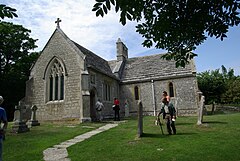User:Huligan0/Tyneham
| Tyneham | |
|---|---|
 Tyneham St Mary's Church - the modern days | |
Location within Dorset | |
| Population | 0 (2001 Census) |
| OS grid reference | SY885805 |
| District | |
| Shire county | |
| Region | |
| Country | England |
| Sovereign state | United Kingdom |
| Police | Dorset |
| Fire | Dorset and Wiltshire |
| Ambulance | South Western |
| UK Parliament | |
Tyneham is a ghost village in south Dorset, England, near Lulworth on the Isle of Purbeck. It remains a civil parish.
Location[edit]

The village is situated northeast of Worbarrow Bay, about six kilometres south of Wareham and about 16 kilometres west of Swanage. It is part of the Lulworth Estate. Tyneham is only accessible when the Lulworth Military Range is open to the public. The military firing range is owned by the Ministry of Defence and is part of the Armoured Fighting Vehicles Gunnery School. Safety warnings about explosives and unexploded shells are posted at Mupe Bay by the MoD, visitors are advised to keep to official footpaths and abide to local site notices, because tanks and Armoured vehicles are used in this area.[1]
History[edit]
Evidence of Roman occupation has been found on several occasions in the valley around Tyneham and there have been fishing communities associated with the parish since the Iron Age.
It seems that it was once the possession of Robert, Count of Mortain the half-brother of William I of England. The village is mentioned in the Domesday Book as Tigeham, meaning "goat enclosure". A century later, the village was known as Tiham and only in later times as Tyneham. The limestone church of St Mary dates from the 13th Century.
In 1683 Nathaniel Bond (1634–1707) of Lutton acquired Tyneham from the Williams family. He also bought Creech Grange in 1691[2] and the family still hold their Purbeck estates.
The village and 7,500 acres (30 km²) of surrounding heathland and chalk downland around the Purbeck Hills, were commandeered just before Christmas 1943 by the then War Office (now MoD) for use as firing ranges for training troops.[3] 252 people were displaced, the last person leaving a notice on the church door:
"Please treat the church and houses with care; we have given up our homes where many of us lived for generations to help win the war to keep men free. We shall return one day and thank you for treating the village kindly."[4]
This measure was supposed to be temporary for the duration of World War II, but in 1948 the Army placed a compulsory purchase order on the land and it has remained in use for military training ever since.[5] Though littered with scrap used as targets, and subject to regular shelling, the land has become a haven for wildlife as it has been free from farming and development. In 1975, after complaints from tourists and locals, the Ministry of Defence began opening the village and footpaths across the ranges at weekends and throughout August. Many of the village buildings have fallen into disrepair or have been damaged by shelling and in 1967 the then Ministry of Works pulled down the Elizabethan manor house, though the church remains intact, and has a stained-glass window by Martin Travers. The church and school house have since been preserved as museums.[4]
In the 1980s the village was used for the filming of Comrades, which tells the story of the Tolpuddle Martyrs. The church had a fibreglass tower and large additional gravestones added and the village's Post Office Row was fronted with fibreglass cottages.[4]
Jurassic Coast[edit]
The Jurassic Coast is a World Heritage Site. The coastal exposures along the Jurassic coastline provide a continuous sequence of Triassic, Jurassic and Cretaceous rock formations spanning approximately 185 million years of the Earths history. The rocks along the Jurassic Coast dip gently to the east. Due to this tilting and due to erosion the oldest exposed rocks are found in the west. The younger Cretaceous rocks form the cliffs here in the east[6]. The Village of Tyneham and Worbarrow Bay are part of the Jurassic Coast.
- For further Jurassic sites see: List of places on the Jurassic Coast
Gallery[edit]
-
Worbarrow Bay and Mupe Rocks behind a ruined house.
-
Tyneham St Mary's Church - south transept
-
Tyneham School House
-
Tyheham houses - the shepherd's house, post office and the telephone booth
See also[edit]
- Imber, in Wiltshire on the Salisbury Plain, is another village which was taken over for military purposes
- The Stanford Battle Area, in Norfolk, which contains six villages also taken over for military purposes
References[edit]
- ^ Ministry of Defence (2003). "Safety and access restrictions: Lulworth ranges". Ministry of Defence. Retrieved 2010-11-16.
{{cite web}}: Cite has empty unknown parameter:|month=(help) - ^ Ferris, John (2004). "Oxford Dictionary of National Biography". Oxford University Press. Retrieved 2010-11-16.
{{cite web}}: Cite has empty unknown parameter:|coauthors=(help) - ^ "Dorset's Lost Village". Weymouth-Dorset.co.uk. Retrieved 2010-11-16.
{{cite web}}: Cite has empty unknown parameter:|coauthors=(help) - ^ a b c "Tyneham - Dorset's ghost village". BBC. 2008. Retrieved 2010-11-16.
- ^ Wright, Patrick (2005). The Village That Died for England. Faber & Faber, Limited. ISBN 9780571214419.
- ^ "Dorset and East Devon Coast". UNESCO World Heritage Centre. 2001. Retrieved 2010-11-16.
{{cite web}}: Cite has empty unknown parameter:|coauthors=(help)





